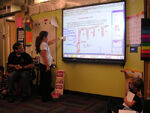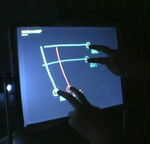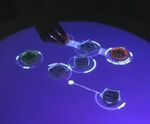Increasingly better user interfaces allow us to benefit from the ongoing computer revolution. By 2020 computers as we know them are likely to disappear to be replaced with ubiquitous computing.
Output[]
Computer displays are extremely versatile - they can display static content, can be used for editing it, adding new content, showing text, images and video. There is no end to what can be done with screens, once you have the technology in place.
Portable projectors[]
Portable projectors are being developed. Their introduction in late 2000s will dramatically change how people interact with one another, they won't hesitate to use more image-based communications. Friends might share more movies and pictures, and business professionals who hesitate to pack a bulky projector for a presentation might start using more visuals when they pitch their products. [1]
Screen size[]
In a sense, the changes screen size form one of the main struggles in the evolution of interfaces. There are two main development directions:
- smaller screens for portable devices
- larger screens for rooms
The progress in this field is very easy to envision by describing the ultimate goals. The smaller screens need a thin (possibly flexible), low-power, bright high-contrast, high-resoution display - the goal is to have something that looks like paper, but can glow (in low light) too. Currently it's various e-paper technologies, some of which are already used in digital watches and ebook readers.

A smart board used in 3rd grade in Columbia University's elementary school
The larger screens need to be high-resolution, very large and bright. Ultimately they need to be arbitrarily large, light and bright so that you can put them on any surface. Currently this segment is covered by large plasma and LCD displays, as well as projectors. Smart boards are already practical for use in education and business.
Television[]
Organic light emitting diode[]
Flexible display[]

flexible display
First prototypes were shown in 2000. First products will be sold in 2008. flexible displays at wikipedia Bill Gates in an interview, along with Steve Jobs, conducted by D5 in May 2007, predicted that the next generation mobile devices, like the palm top, mobile phones or tablet pcs will have this flexible displays which could reduce the form factor and size of the device drastically.
Projector[]

An Explay Nano Projector Pocket Display.
There are many efforts to make portable large displays. That way, you could (say) read your email off your cell phone, by projecting it onto a wall or table. [2]
E-Book[]
An e-book sometimes called an electronic book, is an electronic (or digital) equivalent of a conventional printed book. Sony Reader PSR-500
See also Perfect Portable System.
Sound[]
audio spotlight system Sound in one spot.
Augmented reality[]
Of course, one way to solve the problem of screen size is abandon the idea of the screen and just project the image to the eye somehow (using glasses with projectors or retinal laser projectors). With augmented reality information can be overlayed on the real world images and the real world can even incorporate parts of the virtual world.

A mixed reality interface allowing moving documents between computers, desk surface and wall screen
An interface can include both virtual (digital) object and real (physical) ones. It can use a combination of projectors, videosurfaces and wearable displays. Examples: a real book with virtual 3D images, an interface to move real objects such as business cards or texts to computer display (instantly digitizing them) and moving virtual objects out. [3]
3D displays[]
EyeGlass display applications[]
lumusvision EyeGlass display applications. Virtual reality sunglasses.
Television display applications[]
rewrite - facts, not marketing: Philips 3D Solutions brings the 3D viewing experience to you without the need for special 3D glasses. Philips WoWvx technology grabs the attention of the viewer. The 3D display has a large viewing zone and is suitable for simultaneous use by a number of viewers. 3D is the next big thing since the introduction of color displays. 3D provides a richer, more exciting, more informative, and more entertaining end-user experience in various fields! [4]
3D display applications[]

The best attempt at a 3D display by far
Ever since Star Wars has first shown the 3D hologram of Princess Leia pleading for help, engineers tried to replicate the technology in real life.
Probably the most impressive attempt so far is the 3D technology from AIST (National Institute of Advanced Industrial Science and Technology, Japan). That technology creates fully 3D images consisting of up to 100 dots in the air. It uses laser induced plasma created in the focal point of focused laser light.
Holographic displays[]
One specific type of 3D displays is holographic, where a real hologram is created by lasers dynamically. As of 2007 there is a working prototype developed at MIT. [5] These might become common in the early 2010s.
The Movie Theater[]
New techniques to convert 2-D to 3-D let you see movies in 3-D. Digital projectors avoid color shifts and vibration of typical 3-D. Real D uses polarized glasses to filter images for each eye; in theaters glasses use LCD technology
Input[]
Improvement (or replacement) of the tired workhorses of input — the keyboard and the mouse — is long overdue.
Two technologies that receive most of attention are speech recognition and handwriting recognition.

A FTIR display can sense contact in more than one point video
- Many people hope touch-screen hardware and software will make it much easier to edit and improve drawings including visual language. Visual language, in turn, often gives a reader a better understanding in less time than pure text. This feeds into other trends and speculation -- Scenario: Mind Maps, Category:Education, etc. (Example: Wikipedia: Tablet PC, Pen-Enabled Mac).
- Most displays in the future will be touch sensitive and allow more complex interaction than just point and click FTIR.
- An interesting concept is touch-based interaction with a physics-based desktop interface. [6]
- A new and promising field is gesture controls. Using a tracking technology (such as laser tracking [7]) the computer can see and recognise the gestures that the user makes. This would allow more direct control of the virtual objects than when using a mouse. For example, the user could use both hands and several fingers simulaneously.
- Microsoft have under development a 3D input technology called 'Touchlight'. Using three cameras it is able to guage hand position in 3D space, allowing model building using the hands.
- Equipment similar to existing barcode scanners can track finger tip motion in 3D in 'minority report' fashion. The technique uses a tip tracking mirror pair and a saccade mirror pair - the 'saccade' moves the laser point in a circular fashion, and backscattered light gives an indication of the distance, position and orientation of the target.
- Eye tracking is another interesting solution, where several camers track user's eyeballs and translate them into mouse or cursor movements. [8].
- Commercial grade eye tracking software will soon be integrated into computer games and, according to researchers at Queen's University in Canada, allow programs to respond to people's intentions. That claim is not as fanciful as it may sound. Eye movement decoding is one of the key elements of the (non computer based) Neuro Linguistic programming (NLP) method of body language reading.
- EPOS pen A pen that records everything you write.

Reactable — physical objects and table display are combined into a flexible synthesizer graph video
These technologies require algorithms capable of simulating and controlling a more complex model than traditional simple windows/objects-based interfaces. An example of flexibility that comes from sufficiently complex/advanced algorithms is Teddy [9], a 3D modelling software that even a kid can use after a few minutes of training.
Similar level of flexibility (and naturalness) can be achieved in graph interfaces, making managing data/information/knowledge trivially easy.
- Remapping the Universe video demo, including tactile interface, multi-point input, multi-user displays, large display, direct 3d object manipulation, graph interfaces, physics-based virtual objects, etc.
Microsoft[]
The launch of Microsoft Surface marks the beginning of a new technology category and a user-interface revolution. Surface, Microsoft’s first surface computer, provides effortless interaction with digital content through natural hand gestures, touch and physical objects. Surface computing breaks down traditional barriers between people and technology, changing the way people interact with all kinds of everyday information — from photos to maps to menus.
Artificial Intelligence interface[]
Realistic looking 3D computer asistants organize a persons calender and apointments as predicted by Ray Kurzwiel.
Unsorted predictions[]
- High quality A3 flat displays - using digital paper.
- Colour video display with > 2000 x 2000 pixels
- Large, wall hung high definition colour displays
- Wide screen (>100 in) with contrast ratio of > 10:1
- Video walls, including living area use of VR (scenes)
- Electronic notebook, contrast = paper even after power off
- Video playback over network at 10 x normal speed
- Many people sharing a virtual space
- Positioning sound at any point in space
- 3D TV without need for special glasses
- Personal audio-visual interfaces well developed
- 3D video conferencing
- Computer link to biological sensory organs
- Use of cheap holograms to convey 3D images
- Full integration of processing, audio and video equipment
Brain-computer interface[]
The ultimate interface is brain-computer interface.
External links[]
- Future interfaces - a blog post that I wrote. Should be copied here later.
- The Minority Report Interface - the history of real research into Minority Report-like interfaces
- Future of Human-Computer Interaction - the biggest trends are described (context-awareness, speech recognition, computer vision), especially for mobile devices.
- The Age of the Interface - a review of user interfaces available in the near future.
- User Experience Design - a blog post that I have read.
